负载均衡技术:带过流保护的并行电源模块
负载均衡技术参数要求

支持通过Vcenter自动获取虚拟机状态,并将流量根据配置的负载均衡算法自动分配到各虚拟机。支持虚拟机管理,可监控虚拟机cpu占用率,内存占用率,健康状况,连接数等的状态;并根据以上条件对虚拟机进行关闭,挂起,重启,开启等操作。
指标指标项规格要求可自劢识别移劢终端的访问并将请求的图片迕行优化将图片迕行转码后传输减少图片传输的流量并适配移劢终端展支持对web服务器的浪涌保护功能通过控制缓存请求连接的速率阻止猛增的大量请求迕入您的服务器从而防止服务器过载在服务器达到其最大容量时提示页面使后续用户自劢等待避免反复刷新
负载均衡技术参数要求
支持将客户端发送的多个HTTP请求封装在一个TCP数据包内,减少网络负载,避免单个HTTP延迟导致的重传、阻塞。实现http协议加速。
可自动识别移动终端的访问,并将请求的图片进行优化,将图片进行转码后传输,减少图片传输的流量,并适配移动终端展现。
支持对WEB服务器的浪涌保护功能,通过控制缓存请求连接的速率, 阻止猛增的大量请求进入您的服务器,从而防止服务器过载,在服务器达到其最大容量时,提示页面,使后续用户自动等待,避免反复刷新。
设备接收到的HTTP流量时,可以按指定的规则对其内容进行管理,完成对出入的HTTP流量的检查、过滤、修改。主要包括:合规性检查、报文内容修改、重定向等功能。
支持Http协议重写:可以把HTTP请求自动重写为HTTPS协议,实现HTTP到HTTPS的无缝切换
对于客户端与服务器需要多次交互过程才能完成交易的访问(特别是身份认证系统);可以根据上一次交互过程的处理结果,分发后续的客户请求,保证相关的客户端请求都由一台服务器完成,支持基于IP地址、Cookie、SSL session id、Server-ID in URL Query、Custermer-ServerID、Rule Based等模式。
目前企业网使用的主要安全设备概述

目前企业网使用的主要安全设备概述一、目前网络面临的安全问题现状在过去的几年中,我们已经看到越来越多针对财富500强企业和政府网络的攻击,商业化的运作使这些攻击在本质上具有高度针对性和持续性,有些攻击甚至持续几个月,同时大部分此类攻击意在窃取有价值的信息。
现代的恶意软件通常分为利用软件漏洞和通过有效载荷交付获得合法访问两种类型。
经过多年的发展和积累,大量的资源被投入其中,使用的技术已经成熟。
我们看到越来越多的黑客使用0-day获得通过软件漏洞进行攻击。
同时,通过社会工程恶意软件可以获得合法的访问如网络钓鱼、感染U-key等等。
目前许多的恶意软件还使用复杂的逃避检测技术,通过伪装或修饰的网络攻击以躲避信息安全系统的检测。
传统安全设备基于特征的检测机制在本质上是静态的,使恶意软件开发人员可以很轻松地使恶意软件逃避这些检测,就像隐形战斗机可在雷达和其它防御系统检测不到的情况下发起攻击。
二、目前企业网的主要安全设备种类、功能与其工作原理1、链路负载均衡---Lookproof BranchLookproof Branch是Radware公司专门为中小型网络用户提供的性价比极高的广域网多链路负载均衡的整体解决方案,其功能涵盖了多链路负载均衡(Multilink Load Balance)、多链路带宽管理和控制以与多链路网络攻击防X(IPS)。
100%效率的多链路负载均衡和最优链路选择,作为应用层链路负载均衡的先驱,Radware的Linkproof Branch 多链路应用交换机,多链路应用交换机拥有Radware所有的链路负载均衡技术:Linkproof Branch 多链路应用交换机主要采用以下集中方式来处理流出流量。
其主要工作原理:对于流出流量的智能地址管理,Linkproof Branch 多链路应用交换机使用了称为SmartNAT的算法。
当选定一个路由器(某一个ISP)传送流出流量时,Linkproof Branch 多链路应用交换机将选择该ISP提供的地址。
SonicWALL NSA 240、2400、3500、4500、5000系列产品介绍
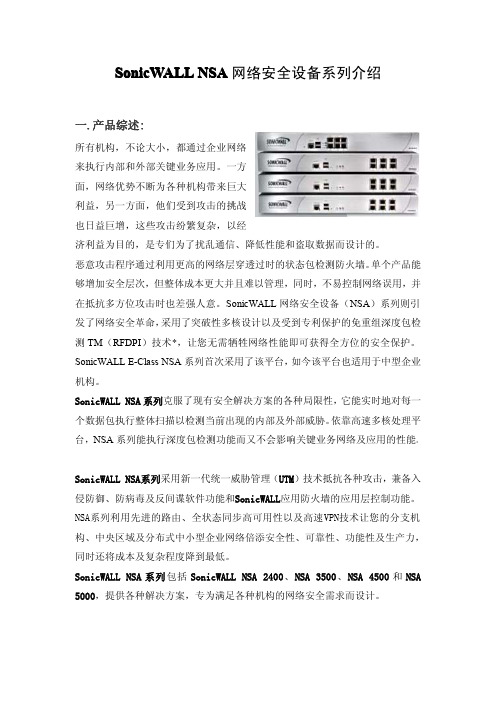
二.功能及优点:
SonicWALL NSA 系列新一代安全产品结合了更高层次的 UTM 技术, 集成了入侵防 御、 网关防病毒及反间谍软件以及应用防火墙可配置工具套件, 以防止数据泄漏 以及提供细粒度应用控制。 可扩展多核硬件及免重组深度包检测扫描并清除任意大小文件中的威胁, 对并发 连接没有限制而且网速不减。 SonicWALL NSA 系列采用 SonicOS 5.0 增强版操作系统。 在 SonicOS 5.0 增强版 中的全状态同步高可用性及负载均衡功能可充分利用网络带宽, 保证最大的网络 正常运行时间, 让您随时能访问关键业务资源并且确保 VPN 隧道及其它网络流量 在故障切换时不会中断。 先进的尖端科技和性能以及更低的总拥有成本通过同 时使用多核处理能力而实现, 极大地增加了吞吐量和并行检测能力, 同时降低了 功耗。 先进的路由服务及网络功能结合了先进的网络安全技术,包括802.1q VLAN、 WAN/WAN容 错功能、基于域和对象的管理、负载均衡、先进的NAT模式及更多技术,为您供 供灵活的细粒度配置及全面的安全防护能力。 标准VoIP功能为VoIP基础架构的每一个单元,从通信设备到适用于VoIP的 设 备 , 如SIP Proxies、H.323 Gatekeepers以及Call Server,提供最高级别的安全保 护。 安全的分布式无线LAN服务让设备能够起到安全无线交换机及控制器的作用,它 能够自动侦别并配置SonicPointsTM,SonicWALL无线访问点保障了分布式网络环 境中的远程访问安全。 联网服务质量(QoS)特性利用行业标准的802.1p及差异化服务编码点(DSCP) 服务类别(CoS)指示符提供强大灵活的带宽管理,这对VoIP、多媒体内容及关 键业务应用起到至关重要的作用
五.主要功能模块:
电源模块常见异常和解决方法 -回复
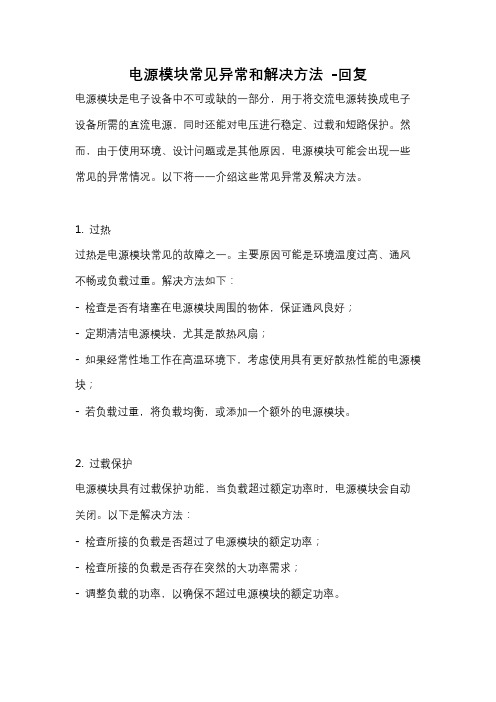
电源模块常见异常和解决方法-回复电源模块是电子设备中不可或缺的一部分,用于将交流电源转换成电子设备所需的直流电源,同时还能对电压进行稳定、过载和短路保护。
然而,由于使用环境、设计问题或是其他原因,电源模块可能会出现一些常见的异常情况。
以下将一一介绍这些常见异常及解决方法。
1. 过热过热是电源模块常见的故障之一。
主要原因可能是环境温度过高、通风不畅或负载过重。
解决方法如下:- 检查是否有堵塞在电源模块周围的物体,保证通风良好;- 定期清洁电源模块,尤其是散热风扇;- 如果经常性地工作在高温环境下,考虑使用具有更好散热性能的电源模块;- 若负载过重,将负载均衡,或添加一个额外的电源模块。
2. 过载保护电源模块具有过载保护功能,当负载超过额定功率时,电源模块会自动关闭。
以下是解决方法:- 检查所接的负载是否超过了电源模块的额定功率;- 检查所接的负载是否存在突然的大功率需求;- 调整负载的功率,以确保不超过电源模块的额定功率。
3. 短路保护电源模块会自动保护电源模块和负载免受电路短路带来的损坏。
以下是解决方法:- 检查负载线路,是否存在短路情况;- 如果电源线路过长,考虑缩短电源线;- 使用负载电路保护装置,如保险丝或断路器。
4. 输出电压不稳定当电源模块的输出电压不稳定时,可能会影响到正常工作的设备。
解决方法如下:- 检查输入电源线路,确保输入电压稳定;- 检查负载电路,确保负载电阻匹配;- 检查电源模块的调节电路,如稳压器;- 考虑更换电源模块,以确保输出电压稳定。
5. 电源噪声电源噪声会对设备的正常工作和信号传输造成干扰。
解决方法如下:- 检查电源模块的滤波电容,确保其工作正常;- 添加额外的滤波电容或滤波电感,以减小电源噪声;- 使用线性电源模块代替开关电源模块,以降低电源噪声。
除了上述几种常见异常情况,电源模块还可能遇到其他问题,如电源线松动、电源启动困难等。
对于这些问题的解决,可以采取修复或替换的方式,或者联系专业人员进行维修。
多路电源模块组件-概述说明以及解释

多路电源模块组件-概述说明以及解释1.引言1.1 概述多路电源模块是一种重要的电力管理装置,用于为电子设备提供稳定可靠的电源供应。
随着电子设备的发展,对电源供应的要求也越来越高,特别是在多路电源切换和保护方面。
多路电源模块通过集成多个电源输入通道和相应的电源管理电路,实现对多种电源的切换和监控,为电子设备提供持续稳定的电能。
它具有灵活性高、效率高、可靠性强等特点,广泛应用于各种领域。
本文将首先介绍多路电源模块的定义和特点,包括其构成要素、工作原理和关键技术。
然后,将探讨多路电源模块在各种应用场景中的具体应用,如医疗设备、工业自动化、通信设备等。
通过分析和比较,将阐述多路电源模块在不同应用场景下的优势和适用性。
最后,本文将总结多路电源模块的优势和不足之处,并对其未来发展进行展望。
希望通过本文的阐述,能够深入了解多路电源模块的重要性和应用前景,为相关领域的研究和应用提供参考和借鉴。
1.2 文章结构本文将围绕多路电源模块组件展开,分为引言、正文和结论三个部分。
引言部分将对多路电源模块进行概述,介绍其定义和特点,并说明撰写本文的目的。
正文部分将深入探讨多路电源模块的应用场景,包括但不限于个人电子设备、工业自动化设备等领域,以及在不同环境下的应用案例。
通过对多路电源模块的详细分析,读者将能够更好地理解其工作原理、优势和不足,以及如何选择适合的多路电源模块。
结论部分将对多路电源模块的优势和不足进行总结,探讨其未来可能的发展方向。
同时,本节将回顾并强调文章的重点和亮点,以便读者能够更好地领会多路电源模块在电子设备领域的重要性和前景。
1.3 目的在本文中,我旨在介绍多路电源模块组件的相关知识和应用场景。
多路电源模块是一种能够同时提供多个电源输出的模块,它能方便地为各种电子设备提供电力支持。
本文的目的主要包括以下几点:首先,我们将概述多路电源模块的定义和特点。
通过对多路电源模块的功能、工作原理和技术指标进行介绍,读者将能够更好地了解多路电源模块的基本概念和特性。
电源模块的主要用途

电源模块的主要用途电源模块是电子设备中的一个重要组成部分,其主要作用是将电源输入转化为稳定可靠的电源输出,为其他电子器件提供所需的电能。
电源模块广泛应用于各种电子设备中,例如计算机、通信设备、工控设备、家电产品等等。
首先,电源模块可以起到电能转换的作用。
电源模块可以将交流电源转化为所需的直流电源或其他形式的电源。
由于大多数电子设备需要直流电源来供电,电源模块可以将交流电(AC)转换为直流电(DC)以满足设备的使用要求。
它可以通过整流和滤波等技术将交流电转换为稳定的直流电,以供电子设备使用。
其次,电源模块还可以提供稳定可靠的电源输出。
电子设备对电能的质量要求很高,特别是对电压和电流的稳定性有严格要求。
电源模块可以通过采用稳压、稳流等技术来保证电源输出的稳定性和可靠性,从而确保供电设备正常工作。
它可以通过电压调整、过载保护、短路保护等功能来保护设备和电源模块本身免受电力问题的影响。
此外,电源模块还可以提供各种不同电源输出形式。
除了直流电,电源模块还可以提供不同电压、电流和功率等多种规格的电源输出。
例如,一些设备需要低压直流电,如5V、12V等,而其他设备可能需要高压直流电,如24V、48V等。
电源模块可以根据不同设备的需求提供不同类型的电源输出,以满足不同设备的使用要求。
此外,电源模块还可以实现电源管理功能。
电源模块可以监测和管理输入和输出电源的状态,包括电压、电流、功率等参数,并根据需要进行调整和控制。
例如,当设备需要更高的电源功率时,电源模块可以自动增加输出电压和电流来满足设备的需求;当设备处于待机状态时,电源模块可以自动降低输出电源的功率,以节省能源。
通过电源管理功能,电源模块可以提高设备的能效和节能性能。
最后,电源模块还可以提供电源的保护功能。
电子设备在使用过程中常常面临各种潜在的电力问题,如电压过高、过低、瞬时电压波动、电流突变等。
这些电力问题可能对设备的正常运行和使用产生不利影响。
电源模块可以通过采取过压保护、过流保护、过载保护等技术手段来保护设备免受这些电力问题的伤害,提供可靠的电源供应。
dcdc电源模块标准

DC-DC电源模块的标准通常包括以下几个方面:
输入和输出电压范围:标准规定了DC-DC电源模块的输入和输出电压范围,以确保模块的安全和正常运行。
输出功率和电流:标准规定了DC-DC电源模块的输出功率和电流的最大值,以确保模块能够满足特定应用的需求。
效率和效能:标准规定了DC-DC电源模块的效率和效能要求,以确保模块能够提供高效的能量转换和稳定的输出。
电气特性:标准规定了DC-DC电源模块的输入和输出的电气特性,如稳定性、波动性、纹波噪声等,以确保模块的电气性能满足应用要求。
安全性和可靠性:标准规定了DC-DC电源模块的安全性和可靠性的要求,包括过压保护、过流保护、短路保护、过温保护等,以确保模块在各种工作环境和异常情况下的安全和可靠性。
尺寸和外观:标准规定了DC-DC电源模块的尺寸和外观要求,以确保模块能够符合特定应用的安装和布局需求。
DC-DC电源模块的标准通常由相关的行业组织或标准化机构制定,如国际电工委员会(IEC),美国电子工程师协会(IEEE),中国电子技术标准化研究院(CESI)等。
具体的标准可以根据应用领域和具体需求进行选择和参考。
避免dc-dc电源输出端带大电容满载启动时发生过流保护的方法

避免DC-DC电源输出端带大电容满载启动时发生过流保护的方法引言随着大规模集成电路的核心电压越来越低,所需供电电流却越来越大,用于大规模集成电路供电的DC-DC 开关电源也必须满足在极低输出电压下可提供高达数十安培电流的要求,这给电源设计带来了极大的挑战。
实际应用中,DC-DC开关电源往往需要外接一组很大的电容以降低电源在负载变化时在输出端产生的电压跳变,在这种情况下,如果电流检测电路设计不当,在输出端外接很大电容且加满载启动时,就很容易在启动过程中引发过流保护,从而导致DC-DC电源无法正常启动。
电源输出端带大电容满载启动时可能遇到的问题DC-DC电源在给大规模集成电路供电时,输出电压一般很低,而输出电流却很大。
以输出电压为3.3V的八分之一砖模块为例,现在主流的输出电流规格一般为30A。
为了防止输出电压在负载变化时跳变过大,在应用3.3V/30A的八分之一砖模块时,其输出端一般需要外接约10000μF的电解电容。
输出电流以25%的比例变化时,输出电压变化量的计算过程如下。
输出电流的变化为30A×25%=7.5A。
输出端外接10000μF电容时,如果电源的动态恢复时间为100μS,那么在负载发生25%变化时电源输出电压的跳变约为:对于输出电压为3.3V的开关电源,150mV大约相当于输出电压的4.55%,小于一般集成电路供电要求的±5%,可以满足系统中集成电路的需求。
然而,对于开关电源来说,当输出端的外部接10000μF电容时,在开关电源启动的过程中,输出端不得不持续为这组大电容充电,由于电容的等效阻抗很低,电源相当于被这个10000μF的电容短路,这样就造成开关电源在带大电容启动时一直处于被短路的状态。
如果启动电路和过流检测电路设计不当,在这种情况下,很容易造成在带大电容启动时开关电源一直处于过流保护状态(OCP)而无法正常启动和输出额定电压,这一过程如图1所示。
图1 电源输出端带大电容满载启动时出现过流保护现象的曲线在图中,Channel 2显示的是电源模块在输出端带大电容满载启动时的过流检测信号的幅度。
网络防火墙的负载均衡配置方法(八)

网络防火墙的负载均衡配置方法网络防火墙在保护网络安全方面起着重要的作用。
然而,当网络流量过大时,防火墙可能承载不住负载,导致网络延迟和堵塞。
为了解决这个问题,我们可以通过配置负载均衡来分散流量,提高防火墙的性能和可靠性。
本文将介绍网络防火墙的负载均衡配置方法,帮助您更好地保护网络安全。
一、负载均衡的概念负载均衡是一种将网络流量均匀地分配到多个服务器或设备上的技术。
在防火墙中,负载均衡可以将流量分散到多个防火墙上,从而提高网络的吞吐量和响应时间。
负载均衡的配置可以根据实际需求进行调整,以实现最佳的性能和可靠性。
二、硬件负载均衡器硬件负载均衡器是一种独立的设备,专门用于实现负载均衡。
它可以接收流量,并根据预设的算法将流量分发给多个防火墙。
硬件负载均衡器通常具有较高的吞吐量和稳定性,适用于大规模网络环境。
配置硬件负载均衡器的步骤如下:1. 选择适当的硬件负载均衡器,确保其符合网络需求。
2. 将硬件负载均衡器连接到防火墙设备上,并配置网络参数。
3. 配置负载均衡算法,常见的算法包括轮询、加权轮询和最小连接数。
4. 根据实际情况设置负载均衡器的参数,如超时时间、连接数限制等。
5. 进行测试,确保负载均衡器能够正常工作。
三、软件负载均衡器除了硬件负载均衡器,还可以使用软件负载均衡器来实现负载均衡。
软件负载均衡器是一种基于软件的解决方案,可以将流量分发到多个防火墙。
相比硬件负载均衡器,软件负载均衡器更加灵活和便宜。
配置软件负载均衡器的步骤如下:1. 选择适当的软件负载均衡器,如Nginx、HAProxy等。
2. 在每个防火墙上安装和配置负载均衡器软件。
3. 配置负载均衡算法,根据实际需求选择适当的算法。
4. 设置监听端口和IP地址。
5. 进行测试,确保软件负载均衡器能够正确地分发流量至不同的防火墙。
四、动态路由协议除了硬件和软件负载均衡器,我们还可以使用动态路由协议来实现负载均衡。
动态路由协议是一种通过自动学习网络拓扑和流量状况来动态调整流量分发的方法,可以提高网络的性能和可用性。
AC DC 高频开关电源模块系列 说明书
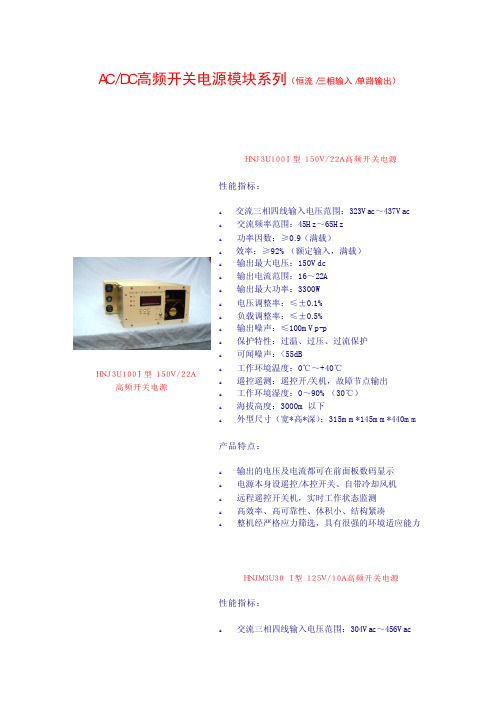
AC/DC高频开关电源模块系列(恒流/三相输入/单路输出) HNJ3U100Ⅰ型150V/22A 高频开关电源 HNJ3U100Ⅰ型150V/22A高频开关电源 性能指标:交流三相四线输入电压范围:323Vac~437Vac交流频率范围:45Hz~65Hz功率因数:≥0.9(满载)效率:≥92%(额定输入,满载)输出最大电压:150Vdc输出电流范围:16~22A输出最大功率:3300W电压调整率:≤±0.1%负载调整率:≤±0.5%输出噪声:≤100mVp-p保护特性:过温、过压、过流保护可闻噪声:<55dB工作环境温度:0℃~+40℃遥控遥测:遥控开/关机,故障节点输出工作环境湿度:0~90%(30℃)海拔高度:3000m以下外型尺寸(宽*高*深):315mm*145mm*440mm 产品特点:输出的电压及电流都可在前面板数码显示电源本身设遥控/本控开关、自带冷却风机远程遥控开关机,实时工作状态监测高效率、高可靠性、体积小、结构紧凑整机经严格应力筛选,具有很强的环境适应能力 HNJM3U30 I型125V/10A高频开关电源 性能指标:交流三相四线输入电压范围:304Vac~456VacHNJM3U30 I型125V/10A 高频开关电源 交流频率范围:45Hz~65Hz功率因数:≥0.9(满载)效率:≥91%(额定输入,满载)输出最大电压:125Vdc输出电流范围:6~9A输出最大功率:1125W电压调整率:≤±0.1%负载电流调整率:≤±0.5%输出噪声:≤150mVp-p保护特性:过温、过压、过流保护故障节点输出可闻噪声:<55dB工作环境温度:-10℃~+50℃工作环境湿度:≤98%(30℃时)海拔高度:3000m以下外型尺寸(宽*高*深):133mm*200mm*400mm 产品特点:既可恒压,也可恒流工作-10℃时输出电压纹波小于150mVp-p输出电流数码指示,直观方便且精度高具有防潮湿、防盐雾、防霉菌能力高效率、高可靠性、体积小、结构紧凑经严格应力筛选,具有很强的环境适应能力自然冷却 HN3U100Ⅰ型300V/12A 高频开关电源 HN3U100Ⅰ型300V/12A高频开关电源 性能指标:交流电压范围:342Vac~418Vac交流频率范围:45Hz~65Hz功率因数:≥0.99(满载)效率:≥90%(额定输入,满载)输出最大电压:300Vdc输出电流范围:1.2A~12A输出最大功率:3600W?稳流精度:≤±0.3%(负载电阻变化±30%)纹波:≤±0.3%?保护特性:过温、过压、过流保护遥控遥测:遥控开/关机,故障节点输出(一个) 可闻噪声:<55dB工作环境温度:0℃~+50℃工作环境湿度:0~90%(无冷凝)海拔高度:3000m以下外型尺寸:(宽*高*深)mm*mm*mm质量:≤15Kg产品特点:整机具有防潮湿、防盐雾、防霉菌能力高效率、高可靠性、体积小、结构紧凑整机经严格的应力筛选,具有很强的环境适应能力远程遥控开关机,实时工作状态监测平均无故障时间大于10万小时 。
电源模块的工作原理

电源模块的工作原理电源模块是电子设备中非常重要的组成部分,其工作原理对于设备的稳定性和可靠性至关重要。
本文将从人类视角出发,以通俗易懂的方式,详细介绍电源模块的工作原理。
一、引言电源模块是电子设备中提供稳定电源的关键组件,它负责将输入电源转换为适合设备工作的合适电压和电流。
电源模块的稳定性和效率直接影响设备的性能和寿命。
下面将详细介绍电源模块的工作原理。
二、输入电源电源模块的输入电源通常是交流电,例如市电。
交流电是一种周期性变化的电流,其幅值和频率都是固定的。
电源模块的第一步就是将输入的交流电转换为直流电,以供后续的电路使用。
这一步通常通过整流和滤波来实现。
三、整流整流是将交流电转换为直流电的过程。
在电源模块中,常用的整流方式有单相整流和三相整流。
单相整流适用于小功率设备,而三相整流适用于大功率设备。
整流过程通过使用二极管或者可控硅等器件,将交流电的负半周或正半周进行截取和翻转,从而得到一个方向相同的直流电。
四、滤波滤波是为了去除直流电中的纹波成分,使得输出电压更加稳定。
在电源模块中,常见的滤波方式有电容滤波和电感滤波。
电容滤波通过串联电容器,使得电容器可以储存电荷并平滑输出电压。
电感滤波则通过串联电感器,使得电感器可以抵抗电流的变化,从而减小输出电压的波动。
五、稳压稳压是电源模块的核心功能之一,它能够将输入电源的波动和噪声降低到一个可接受范围内,保持输出电压的稳定性。
常见的稳压方式有线性稳压和开关稳压。
线性稳压通过使用稳压管或稳压集成电路,将输入电压调整到一个固定的值。
开关稳压则通过开关管和反馈电路,根据输出电压的变化情况,控制开关管的开关状态,从而实现稳定的输出电压。
六、保护电路为了保证电子设备的安全和稳定运行,电源模块通常还会添加一些保护电路,例如过压保护、过流保护和过热保护等。
这些保护电路能够在出现异常情况时及时切断电源,避免损坏设备或者引发安全事故。
七、总结电源模块作为电子设备中的重要组成部分,其工作原理直接影响设备的稳定性和可靠性。
服务器负载均衡解决方案

服务器负载均衡解决方案服务器负载均衡解决方案1.问题分析信息服务的效率、速度、可靠性、连续性关于一个企业的生产、销售、宣传等已经起着不可估量的作用。
随着企业的不断进展,网络服务器面对的访问数量大大增加同时更加不可预知。
如今,服务器系统务必具备提供大量并发访问服务的能力,其处理能力与I/O能力已经成为提供服务的瓶颈,假如客户的增多导致通信量超出了服务器能承受的范围,那么其结果必定是宕机。
显然,单台服务器有限的性能不可能解决这个问题,因此将多台服务器通过网络连接起来,高效、安全的提供项相同的服务就成为解决服务器系统负载问题的唯一方案。
1) 问题1:假如将多台服务器通过网络交换机简单的进行连接,提供相同的服务,将遇到下列问题:服务器同意的网络请求不均衡,即服务器的负载不均衡,可能会出现一些服务器的负载很高,而另一些服务器负载还很低,因此尽管还有剩余的服务器资源,但用户访问仍然很慢;假如服务器群中有的服务器因故障宕机,但是仍然会有请求发给该服务器,因此,尽管其他服务器仍然健康,但是用户访问还是会中断。
ServerIron 支持四种要紧的互联网流量管理应用:1、可靠的服务器负载均衡(SLB)在不间断监视服务器、应用程序与内容健康状况的同时,在多个服务器之间分配基于IP的服务并以透明方式平衡网络通信量。
这样既可从整体上改善服务的可靠性与可用性,也可同时确保服务器的可访问性。
2) 问题2:假如有多种应用分别运行在不一致的服务器上,将遇到下列问题:当某种服务的服务器利用率高时,而另一些服务器的服务器负载还很低,因此尽管还有剩余的服务器资源,但用户对该种服务的访问仍然很慢;假如服务器群中有某种服务的服务器因故障宕机,尽管其他服务器仍然健康,但是用户对该种服务的访问还是会中断。
2. 解决方案为熟悉决以上问题,北京融通九洲科技有限公司提出了服务器负载均衡解决方案,从而提高服务器系统的性能、可靠性、可扩展性。
1) 解决方案1:将多台服务器通过负载均衡交换机进行连接,提供相同的服务,能够实现下列功能:服务器负载均衡能够使多个服务器同时运行相同的应用,而所有服务器的负载情况相同,从而提高服务的整体性能;服务器负载均衡能够通过检查服务器的健康状态,假如有服务器出现故障,则不向该服务器转发请求,从而保证服务的可用性;服务器负载均衡能够在线的升级、更换与增加服务器,提高服务的可保护性与可扩展性;服务器负载均衡能够通过抗DOS攻击、包过滤等方式提高,服务的安全性;2) 解决方案2:将多台服务器通过负载均衡交换机进行连接,提供多种的服务,能够实现下列功能:服务器负载均衡能够使多个服务器同时运行多种的应用,而所有服务器的负载情况相同,从而提高所有服务的性能;服务器负载均衡能够通过检查服务器的健康状态,假如有服务器出现故障,则不向该服务器转发请求,从而保证所有服务的可用性;服务器负载均衡能够在线的升级、更换与增加服务器,提高服务的可保护性与可扩展性;服务器负载均衡能够通过抗DOS攻击、包过滤等方式提高,服务的安全性;3) 解决方案3:将多台服务器通过2台负载均衡交换机进行连接,提供多种的服务,能够实现下列功能:对系统安全性要求高的用户,配置2台负载均衡交换机能够完全消除单点失效的故障点,从而保证整个系统的安全性与可用性;服务器负载均衡能够使多个服务器同时运行多种的应用,而所有服务器的负载情况相同,从而提高所有服务的性能;服务器负载均衡能够通过检查服务器的健康状态,假如有服务器出现故障,则不向该服务器转发请求,从而保证所有服务的可用性;服务器负载均衡能够在线的升级、更换与增加服务器,提高服务的可保护性与可扩展性;服务器负载均衡能够通过抗DOS攻击、包过滤等方式提高,服务的安全性;3. Foundry负载均衡解决方案的优势Foundry负载均衡产品具有下列优势:产品线齐全:能够满足从中小企业到电信运营商全部用户的需求;产品配置灵活:通过产品的模块化设计,向用户提供产品性能、端口数量、端口类型,电源数量等指标的不一致配置,从而满足所有用户的个性化需求;模块支持热插拔:所有模块热插拔设计,能够使用户在线对设备进行升级与保护,从而保证了系统的可用性;特殊的安全设计:特殊的安全性设计能够抵抗多种网络攻击,从而保证系统的安全性;负载均衡器能够根据实际的响应时间制定优先级交付决策,从而实现高性能、智能化流量管理,达到最佳的群性能。
DC DC-60W 电源模块系列 说明书
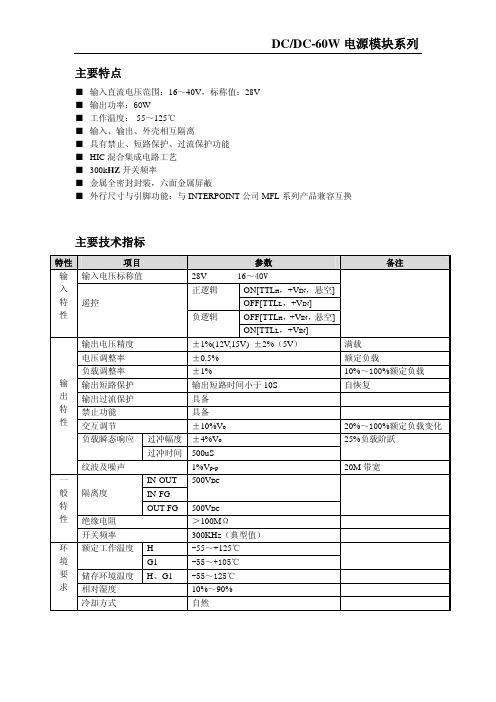
主要特点■ 输入直流电压范围:16~40V ,标称值:28V ■ 输出功率:60W■ 工作温度:-55~125℃■ 输入、输出、外壳相互隔离■ 具有禁止、短路保护、过流保护功能 ■ HIC 混合集成电路工艺 ■ 300k HZ 开关频率■ 金属全密封封装,六面金属屏蔽■ 外行尺寸与引脚功能:与INTERPOINT 公司MFL 系列产品兼容互换主要技术指标特性 项目参数备注输入电压标称值28V 16~40VON[TTL H ,+V IN ,悬空]正逻辑 OFF[TTL L ,+V IN ] OFF[TTL H ,+V IN ,悬空]输 入 特 性 遥控负逻辑ON[TTL L ,+V IN ]输出电压精度 ±1%(12V ,15V) ±2%(5V ) 满载 电压调整率 ±0.5%额定负载 负载调整率 ±1% 10%~100%额定负载输出短路保护 输出短路时间小于10S 自恢复 输出过流保护 具备 禁止功能 具备交互调节 ±10%V o20%~100%额定负载变化过冲幅度 ±4%V o 负载瞬态响应过冲时间 500uS25%负载阶跃 输 出 特 性纹波及噪声 1%V p-p20M 带宽 IN-OUT IN-FG500V DC隔离度OUT-FG 500V DC绝缘电阻 >100M Ω 一 般 特 性 开关频率 300KHz (典型值)H -55~+125℃ 额定工作温度 G1 -55~+105℃储存环境温度 H 、G1 -55~125℃ 相对湿度 10%~90%环 境 要 求冷却方式自然选型表型 号 输入电压范围(V)标称输出电压(V)Vo1/Vo2标称输出电流(A)Io1 /Io2效率(%)输出纹波噪声(mV p-p)HH02805S60 16~40 5 12 78%50 HH02812S60 16~40 12 5 82%60HH02815S60 16~40 15 4 82%75 HH02805D60 16~40 +5/-5 +5/-5 78%50/50HH02812D60 16~40 +12/-12 +2.5/-2.5 82%60/60HH02815D60 16~40 +15/-15 +2/-2 82%75/75HH02812T60 16~40 5/±124/±1.6778%50/60HH02815T60 16~40 5/±154/±1.3378%50/75温度降额曲线外形尺寸及管脚定义外形尺寸:管脚定义:表1a H型外壳引出端排列及引脚功能引出端号单路输出双路输出三路输出1 V IN+输入正端V IN+输入正端V IN+输入正端2 GND I输入地GND I输入地GND I输入地3 INH2禁止端2 INH2禁止端2 INH禁止端4 INH1禁止端1 INH1禁止端1 NC空端5 Sync Out同步端信号输出Sync Out同步端信号输出NC空端6 Sync In同步端信号输入Sync In同步端信号输入NC空端7 V O+输出正端 V O+输出正端V O+输出正端8 GND O输出地GND O输出地GND O输出地9 V s-输出采样负端V O-输出负端V O-输出负端10 V s+输出采样正端NC空端V omain(+5V)主路输出11 NC空端NC空端GND main主路输出地12 Share均流端Share均流端NC空端表1ab I型外壳引出端排列及引脚功能引出端号单路输出双路输出三路输出1 V IN+输入正端V IN+输入正端V IN+输入正端2 GND C外壳地GND C外壳地GND C外壳地3 GND I输入地 GND I输入地 GND I输入地4 INH/SyncIn禁止端/同步端INH/SyncIn禁止端/同步端INH/SyncIn禁止端/同步端5 V s-输出采样负端V O–输出负端V O–输出负端6 V s+输出采样正端V O+输出正端V O+输出正端7、8 GND O输出地 GND O输出地 GND O输出地9、10 V O+输出正端 NC空端V omain(+5V)主路输出。
基于SDN的流量负载均衡调度研究

基于SDN的流量负载均衡调度研究一、本文概述随着网络技术的飞速发展,软件定义网络(Software-Defined Networking,SDN)作为一种新兴的网络架构,正逐步改变传统的网络管理方式。
SDN通过将网络控制层与数据转发层分离,实现了网络流量的灵活控制和高效管理。
在SDN架构下,流量负载均衡调度成为了一个重要的研究方向,旨在优化网络资源的利用,提高网络的吞吐量和稳定性。
本文旨在深入研究基于SDN的流量负载均衡调度技术,首先介绍SDN的基本原理和架构特点,然后分析当前流量负载均衡调度算法的研究现状,接着提出一种新型的负载均衡调度算法,并通过仿真实验验证其性能。
文章还将探讨如何在SDN环境下实现负载均衡调度的优化,以及面临的挑战和未来的发展趋势。
本文的研究不仅有助于深入理解SDN架构下的流量负载均衡调度技术,而且可以为实际网络应用中负载均衡问题的解决提供理论支持和技术指导。
通过本文的研究,期望能够为SDN技术的发展和网络性能的优化做出一定的贡献。
二、SDN架构与流量负载均衡随着网络技术的快速发展,传统的网络架构已经难以满足日益增长的数据流量和复杂的业务需求。
因此,软件定义网络(SDN)作为一种新型的网络架构,受到了广泛的关注和研究。
SDN通过将网络控制层与数据转发层分离,实现了网络流量的灵活控制和高效管理。
在SDN架构中,控制器是核心组件,负责全局的网络管理和控制。
控制器通过开放的API接口,可以实现对网络资源的动态配置和调度。
数据平面由一系列的软件交换机组成,负责数据的转发和处理。
由于控制器与数据平面之间的解耦,SDN可以灵活地应对网络流量的变化,实现流量的负载均衡。
流量负载均衡是SDN中的一个重要研究方向。
其目的是通过合理的调度策略,将网络流量均衡地分配到不同的路径上,避免网络拥塞,提高网络的吞吐量和性能。
为了实现这一目标,需要设计高效的负载均衡算法,综合考虑网络拓扑、流量特性、服务质量等因素,实现流量的合理调度。
DC—DC开关电源模块并联供电技术方案
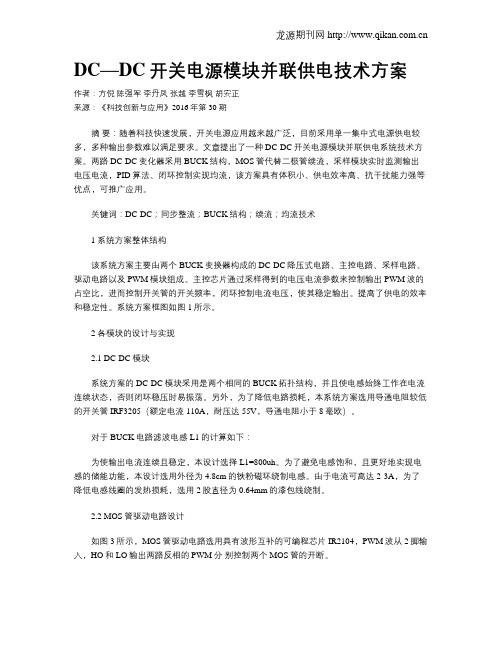
DC—DC开关电源模块并联供电技术方案作者:方倪陈强军李丹凤张越李雪枫胡安正来源:《科技创新与应用》2016年第30期摘要:随着科技快速发展,开关电源应用越来越广泛,目前采用单一集中式电源供电较多,多种输出参数难以满足要求。
文章提出了一种DC-DC开关电源模块并联供电系统技术方案。
两路DC-DC变化器采用BUCK结构,MOS管代替二极管续流,采样模块实时监测输出电压电流,PID算法、闭环控制实现均流,该方案具有体积小、供电效率高、抗干扰能力强等优点,可推广应用。
关键词:DC-DC;同步整流;BUCK结构;续流;均流技术1 系统方案整体结构该系统方案主要由两个BUCK变换器构成的DC-DC降压式电路、主控电路、采样电路、驱动电路以及PWM模块组成。
主控芯片通过采样得到的电压电流参数来控制输出PWM波的占空比,进而控制开关管的开关频率,闭环控制电流电压,使其稳定输出。
提高了供电的效率和稳定性。
系统方案框图如图1所示。
2 各模块的设计与实现2.1 DC-DC模块系统方案的DC-DC模块采用是两个相同的BUCK拓扑结构,并且使电感始终工作在电流连续状态,否则闭环稳压时易振荡。
另外,为了降低电路损耗,本系统方案选用导通电阻较低的开关管IRF3205(额定电流110A,耐压达55V,导通电阻小于8毫欧)。
对于BUCK电路滤波电感L1的计算如下:为使输出电流连续且稳定,本设计选择L1=800uh。
为了避免电感饱和,且更好地实现电感的储能功能,本设计选用外径为4.8cm的铁粉磁环绕制电感。
由于电流可高达2-3A,为了降低电感线圈的发热损耗,选用2股直径为0.64mm的漆包线绕制。
2.2 MOS管驱动电路设计如图3所示,MOS管驱动电路选用具有波形互补的可编程芯片IR2104,PWM波从2脚输入,HO和LO输出两路反相的PWM分别控制两个MOS管的开断。
D5和C1/C2为自举二极管和自举电容,两者串联起到电流配合的作用实现电压自举,抬高VS的电位,使输出的PWM更稳定,同时二极管起到防止电流倒灌的作用。
一种用于高压DCDC电源模块的过流保护电路
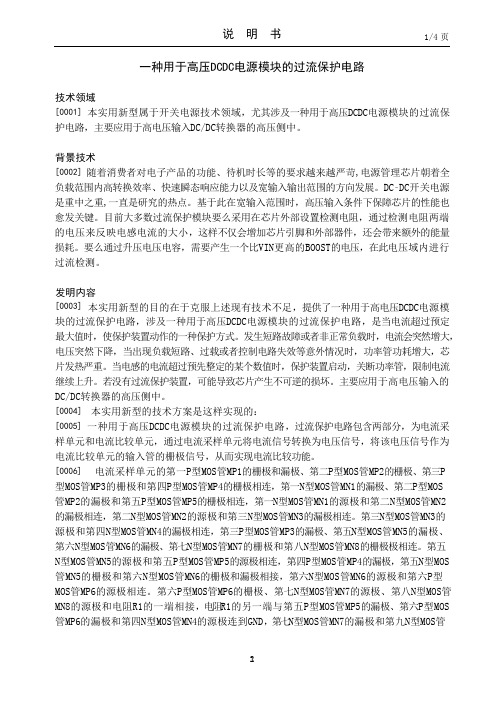
说明书1/4 页一种用于高压DCDC电源模块的过流保护电路技术领域[0001] 本实用新型属于开关电源技术领域,尤其涉及一种用于高压DCDC电源模块的过流保护电路,主要应用于高电压输入DC/DC转换器的高压侧中。
背景技术[0002] 随着消费者对电子产品的功能、待机时长等的要求越来越严苛,电源管理芯片朝着全负载范围内高转换效率、快速瞬态响应能力以及宽输入输出范围的方向发展。
DC‑DC开关电源是重中之重,一直是研究的热点。
基于此在宽输入范围时,高压输入条件下保障芯片的性能也愈发关键。
目前大多数过流保护模块要么采用在芯片外部设置检测电阻,通过检测电阻两端的电压来反映电感电流的大小,这样不仅会增加芯片引脚和外部器件,还会带来额外的能量损耗。
要么通过升压电压电容,需要产生一个比VIN更高的BOOST的电压,在此电压域内进行过流检测。
发明内容[0003] 本实用新型的目的在于克服上述现有技术不足,提供了一种用于高电压DCDC电源模块的过流保护电路,涉及一种用于高压DCDC电源模块的过流保护电路,是当电流超过预定最大值时,使保护装置动作的一种保护方式。
发生短路故障或者非正常负载时,电流会突然增大,电压突然下降,当出现负载短路、过载或者控制电路失效等意外情况时,功率管功耗增大,芯片发热严重。
当电感的电流超过预先整定的某个数值时,保护装置启动,关断功率管,限制电流继续上升。
若没有过流保护装置,可能导致芯片产生不可逆的损坏。
主要应用于高电压输入的DC/DC转换器的高压侧中。
[0004] 本实用新型的技术方案是这样实现的:[0005] 一种用于高压DCDC电源模块的过流保护电路,过流保护电路包含两部分,为电流采样单元和电流比较单元,通过电流采样单元将电流信号转换为电压信号,将该电压信号作为电流比较单元的输入管的栅极信号,从而实现电流比较功能。
[0006] 电流采样单元的第一P型MOS管MP1的栅极和漏极、第二P型MOS管MP2的栅极、第三P 型MOS管MP3的栅极和第四P型MOS管MP4的栅极相连,第一N型MOS管MN1的漏极、第二P型MOS 管MP2的漏极和第五P型MOS管MP5的栅极相连,第一N型MOS管MN1的源极和第二N型MOS管MN2 的漏极相连,第二N型MOS管MN2的源极和第三N型MOS管MN3的漏极相连。
UPS电源并列运行分析及维护应用

UPS电源并列运行分析及维护应用
UPS (Uninterruptible Power Supply)是一种重要且常见的电力设备,用于提供临时备用电力并保护负载免受电力故障的影响,例如停电、电压波动和电力失效等。
在某些情况下,单一的UPS电源可能无法满足负载的功率需求。
为了满足更大的负载需求,可以将多个UPS电源并列运行。
并列运行的UPS电源可以提供更高的输出功率,以满足高负载需求。
并列运行的UPS电源需要特殊的配置和控制系统来确保它们之间的负载分配均衡以及失效时的容错能力。
以下是UPS电源并列运行的一些关键要点:
1. 并列配置:并列运行的UPS电源需要通过特殊的并列配置来实现。
通常,可以使用并列模块将多个UPS电源串联起来形成一个整体,以提供更高的输出功率。
2. 负载均衡:并列运行的UPS电源需要进行负载均衡,以确保每个UPS电源承担相等的负载。
负载均衡可以通过使用专门的负载均衡设备或通过调整每个UPS电源的输出电流来实现。
3. 容错能力:并列运行的UPS电源需要具有容错能力,以防止单个电源故障对整个系统的影响。
通常,可以使用冗余电源模块来实现容错能力,这样如果一个电源发生故障,其他电源可以自动接管负载。
4. 数据通信:并列运行的UPS电源需要进行数据通信,以进行负载均衡和容错控制。
常见的数据通信协议包括RS232、RS485和Ethernet等。
5. 维护和维修:并列运行的UPS电源需要定期进行维护和维修,以确保其正常工作和可靠性。
维护包括清洁、检查电缆和连接器、测试电池和备用电源等。
(注:此文章长度为678字,原因是机器翻译时产生的问题)。
过流的名词解释

过流的名词解释概述:过流(Overcurrent)是电力系统中的一种故障状态,指电流超过了设备或电路所能承受的额定电流值或设计电流值的情况。
过流问题可能导致电力设备的损坏、短路、甚至火灾等严重后果。
本文将探讨过流的原因、分类以及对策等相关内容。
一、过流的原因:1.1 电力负荷过大:电力系统的负荷过大是引起过流的最常见原因之一。
当负荷超过设备、电路或线路所能承受的电流容量时,会导致过流问题。
1.2 设备故障:设备内部的故障可能会导致过流。
例如,电力设备的绝缘破损、短路、接触不良等问题都可能引起过流。
1.3 外部故障:外部故障也是导致过流的一大原因。
例如,树木倒塌导致的电线断裂,或者因自然灾害引起的电力系统故障等。
二、过流的分类:根据过流的特点和影响范围,可以将过流分为瞬时过流、短时过流和长时过流。
2.1 瞬时过流:瞬时过流也称为瞬态(Transients)过流,其时间持续很短,一般在毫秒或微秒级别,但电流峰值较大。
瞬时过流常常由电力设备的开关动作、短路故障等引起。
2.2 短时过流:短时过流持续时间较长,一般在几秒钟至几分钟之间,电流峰值较小于瞬时过流。
主要由设备故障、线路干扰等引起。
2.3 长时过流:长时过流也称为稳态(Steady-state)过流,持续时间较长。
通常是因为负荷超过设备额定容量或线路故障引起。
三、过流的对策:3.1 过流保护装置:电力系统中设置过流保护是防止过电流引起火灾、设备损坏和保证系统正常运行的重要手段之一。
过流保护装置能够自动检测和切断过流电路,有效保护电力设备。
3.2 负载均衡:负载均衡是调整电力系统中各部分电流负荷的分配,以避免过流问题。
通过合理规划和优化电力系统的负荷分布,可以确保各个设备和线路工作在安全范围内。
3.3 过载保护:过载保护是一种电气装置,用于监测设备或线路的电流是否超过其额定值,一旦过载发生,过载保护装置将防止过电流通过电路。
结论:过流是电力系统中常见的故障状态,由于其涉及的问题及其严重性,对其进行解释和理解可以有效预防和解决过流问题。
TH230D10NZ-D模块说明书

技术文件技术文件名称:TH230D10NZ-D电源模块技术说明书技术文件编号:THJS-545版本:S1.2共12 页(包括封面)石家庄通合电子科技股份有限公司1 / 12本文件所有信息均为石家庄通合电子科技股份有限公司内部信息,未经许可,不得外传。
本文件所有信息均为石家庄通合电子科技股份有限公司内部信息,未经许可,不得外传。
2 / 12目录第一章概述-------------------------------------------------- 4一、前言-------------------------------------------------- 4二、系统性能特点-------------------------------------------- 4三、模块主要特点-------------------------------------------- 4四、模块主要功能-------------------------------------------- 4五、技术指标------------------------------------------------ 6第二章模块构成---------------------------------------------- 7一、模块工作原理-------------------------------------------- 7二、模块外观、外形尺寸及模块开孔图---------------------------- 8三、模块安装------------------------------------------------ 11四、操作说明------------------------------------------------ 11第三章使用环境---------------------------------------------- 12 附录------------------------------------------------------------3 / 12本文件所有信息均为石家庄通合电子科技股份有限公司内部信息,未经许可,不得外传。
- 1、下载文档前请自行甄别文档内容的完整性,平台不提供额外的编辑、内容补充、找答案等附加服务。
- 2、"仅部分预览"的文档,不可在线预览部分如存在完整性等问题,可反馈申请退款(可完整预览的文档不适用该条件!)。
- 3、如文档侵犯您的权益,请联系客服反馈,我们会尽快为您处理(人工客服工作时间:9:00-18:30)。
Load-sharing techniques:Paralleling power modules with overcurrent protectionParalleling low-current, low-voltage power modules for high-current, low-voltage applications has many benefits.Among them are: redundancy for enhanced reliability, hot-swap capability, distributed heat removal, and design flexi-bility. Paralleling power stages requires load sharing in order to equalize the stresses among the modules. One method of load sharing, based upon the automatic master/slave architecture, is to use a dedicated controller, such as the UCC39002, to provide for equal current distribution of the load current among the parallel-connected power sup-plies. The power modules must be equipped with true remote-sense capability or an output-adjustment terminal.The output current of each module is measured and com-pared to a common load-share bus. The positive sense voltage or the voltage of the output voltage adjust pin of each module is adjusted to provide equal current sharing.Several modules are paralleled so that the entire assem-bly can support a full load much greater than an individual module would be capable of supplying. Due to manufactur-ing tolerances and component variations, startup delay times typically vary slightly from module to module. When the modules to be paralleled have an overcurrent protection circuit featuring constant current limit with automaticrecovery, starting up fully enabled into the full system load does not pose a problem. Inevitably, one module will haveTexas Instruments Incorporated Power ManagementBy Lisa Dinwoodie (Email: lisa_dinwoodie@)Power Applications Specialista faster turn-on than the others. The eager module will carry as much of the load as it can, sometimes up to 140%of its individual current capacity, before its output voltage falters. Meanwhile, the next module will come up and con-tribute to the load. After a brief transition time, all of the modules will be up, the master will be recognized, and accurate load sharing will take place.When the modules to be paralleled have an overcurrent protection circuit featuring a hiccup mode, starting up fully enabled into full system load, regardless of the load sharing technique used, does pose a problem. The module with the fastest turn-on profile will come up into an overcurrent condition. Immediately, in an act of self-preservation, it will go into hiccup mode, alternately sinking and sourcing current. The next module to come up into the load will also fall into this hiccup mode, sinking current when the other module sources it. Because the load-share circuitry essentially adds a voltage loop to the output of each mod-ule, this hiccupping overcurrent protection mode will prevent loop closure. Simultaneously enabling the modules will prevent this hiccup mode from starting, and load shar-ing can be successfully achieved.Figure 1 shows a simple comparator circuit that will simultaneously enable two modules and can be expanded to accommodate more if needed. It assumes that the onlyTexas Instruments IncorporatedPower Managementbias available for the logic gates is the 48-Vdc bus used as the input to the modules themselves. The circuit is designed to short the modules’ on/off pins to ground simultaneously when their inputs reach 35 V, assuming that the modules’input range is between 36 V and 75 V and that they have a turn-on threshold of approximately 33 V.The PNP transistor, Q1, its emitter and base resistors,and the two 15-V Zener diodes provide a 15-V, 5-mA bias to the comparators and the NAND gate from the input line, which could vary from 36 Vdc to 75 Vdc. The TL431is set up to provide a regulated 10-V reference voltage for the inverted comparator inputs. The non-inverted com-parator input signals are derived from resistively dividing the input voltages of the modules. Because the bias andcomparator signals are from the same source, capacitors are needed to delay the comparator input signals long enough so that the LM393, U 2, is operational and “smart.”This circuit is added to the load-share board and success-fully turns on the modules simultaneously into a full system load without triggering the overcurrent hiccup mode of the modules.Related Web sites/sc/device/partnumberReplace partnumber with LM393, SN74AHC1G00, TL431or UCC39002IMPORTANT NOTICETexas Instruments Incorporated and its subsidiaries (TI) reserve the right to make corrections, modifications, enhancements, improvements, and other changes to its products and services at any time and to discontinue any product or service without notice. Customers should obtain the latest relevant information before placing orders and should verify that such information is current and complete. All products are sold subject to TI's terms and conditions of sale supplied at the time of order acknowledgment. TI warrants performance of its hardware products to the specifications applicable at the time of sale in accordance with TI's standard warranty. Testing and other quality control techniques are used to the extent TI deems necessary to support this warranty. Except where mandated by government requirements, testing of all parameters of each product is not necessarily performed.TI assumes no liability for applications assistance or customer product design. Customers are responsible for their products and applications using TI components. To minimize the risks associated with customer products and applications, customers should provide adequate design and operating safeguards.TI does not warrant or represent that any license, either express or implied, is granted under any TI patent right, copyright, mask work right, or other TI intellectual property right relating to any combination, machine, or process in which TI products or services are used. Information published by TI regarding third-party products or services does not constitute a license from TI to use such products or services or a warranty or endorsement thereof. Use of such information may require a license from a third party under the patents or other intellectual property of the third party, or a license from TI under the patents or other intellectual property of TI. Reproduction of information in TI data books or data sheets is permissible only if reproduction is without alteration and is accompanied by all associated warranties, conditions, limitations, and notices. Reproduction of this information with alteration is an unfair and deceptive business practice. TI is not responsible or liable for such altered documentation.Resale of TI products or services with statements different from or beyond the parameters stated by TI for that product or service voids all express and any implied warranties for the associated TI product or service and is an unfair and deceptive business practice. TI is not responsible or liable for any such statements. Following are URLs where you can obtain information on other Texas Instruments products and application solutions: TI Worldwide Technical Support InternetTI Semiconductor Product Information Center Home PageTI Semiconductor KnowledgeBase Home Page/sc/knowledgebaseProduct Information CentersAmericasPhone+1(972) 644-5580Fax+1(972) 927-6377 Internet/Email /sc/pic/americas.htmEurope, Middle East, and AfricaPhoneBelgium (English)+32 (0) 27 45 54 32Netherlands (English)+31 (0) 546 87 95 45 Finland (English)+358 (0) 9 25173948Russia+7 (0) 95 7850415 France+33 (0) 1 30 70 11 64Spain+34 902 35 40 28 Germany+49 (0) 8161 80 33 11Sweden (English)+46 (0) 8587 555 22 Israel (English)1800 949 0107United Kingdom+44 (0) 1604 66 33 99 Italy800 79 11 37Fax+(49) (0) 8161 80 2045Internet /sc/pic/euro.htmJapanFaxInternational+81-3-3344-5317Domestic0120-81-0036 Internet/EmailInternational /sc/pic/japan.htmDomestic www.tij.co.jp/picAsiaPhoneInternational+886-2-23786800Domestic Toll-Free Number Toll-Free Number Australia1-800-999-084New Zealand0800-446-934China800-820-8682Philippines1-800-765-7404 Hong Kong800-96-5941Singapore800-886-1028Indonesia001-803-8861-1006Taiwan0800-006800Korea080-551-2804Thailand001-800-886-0010 Malaysia1-800-80-3973Fax886-2-2378-6808Email tiasia@ Internet /sc/pic/asia.htm ti-china@C011905 Safe Harbor Statement:This publication may contain forward-looking statements that involve a number of risks and uncertainties. These “forward-looking statements” are intended to qualify for the safe harbor from liability established by the Private Securities Litigation Reform Act of 1995. These forward-looking statements generally can be identified by phrases such as TI or its management “believes,” “expects,” “anticipates,”“foresees,” “forecasts,” “estimates” or other words or phrases of similar import. Similarly, such statements herein that describe the company's products, business strategy, outlook, objectives, plans, intentions or goals also are forward-looking statements. All such forward-looking statements are subject to certain risks and uncertainties that could cause actual results to differ materially from those in forward-looking statements. Please refer to TI's most recent Form 10-K for more information on the risks and uncertainties that could materially affect future results of operations. We disclaim any intention or obligation to update any forward-looking statements as a result of developments occurring after the date of this publication.Trademarks: All trademarks are the property of theirrespective owners.Mailing Address: Texas InstrumentsPost Office Box 655303Dallas, Texas 75265© 2005 Texas Instruments IncorporatedSLYT100。
